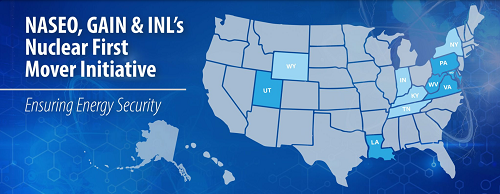
Latest News
Advanced Nuclear First Mover Initiative: Ready, set, grow
April 7, 2025
By Donna Kemp Spangler
GAIN and NASEO help states fast-track nuclear energy development
Eleven governors and their state energy offices are putting out ready-for-business signs to advanced nuclear energy developers under an initiative that taps into experts at the Idaho National Laboratory (INL).
The National Association of State Energy Officials (NASEO) partnered with the U.S. Department of Energy’s (DOE) Gateway for Accelerated Innovation in Nuclear (GAIN) to launch the Advanced Nuclear First Movers Initiative. The Initiative, directed by state energy offices, is led by state co-chairs New York, Indiana, Kentucky, Tennessee and Wyoming, and the participating states Louisiana, Maryland, Pennsylvania, Utah, Virginia and West Virginia.
The initiative will work with experts at INL and Oak Ridge National Laboratory to help:
- Devise supportive market adoption policies.
- Define supply chain needs.
- Develop coordinated procurement options.
- Explore state-federal-private financing structures.
- Create public-private partnerships.
“By doing so, the initiative aims to reduce the cost of advanced nuclear projects and deliver more power to the electric grid, ultimately meeting growing power needs with firm, abundant power to ensure reliability, affordability and economic growth,” said NASEO President David Terry.

GAIN draws on the expertise at INL and across the national laboratory complex to support states at various stages of their nuclear energy readiness. GAIN has compiled a robust resources library that provides information on regulations and advanced technologies and tracks state legislation to inform what nuclear policies have been implemented.
“Eleven nuclear-ready states are ready to roll up their sleeves and dig into the details associated with deploying nuclear energy as a group,” said Christine King, director of GAIN. “Each of these states has been working on their individual strategies. In this group we expect to see partners emerge with common goals and complementary timelines. It’s very exciting.”
